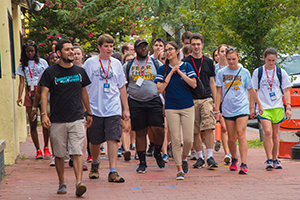In the Community
Explore DC: New AU Students Quickly Acclimate to Washington

AU students recently visited the Central American Resource Center as part of a tour through Mount Pleasant and Columbia Heights.
Last week, Gabrielle Velasco was speaking to a group of American University students about the obstacles facing immigrants in Washington, DC. Though just an ordinary summer day, Velasco might have experienced déjà vu. As the citizenship coordinator at the Central American Resource Center, she was imparting insights to new AU students involved in Explore DC. But not too long ago she was a first-year AU student in Freshman Service Experience—an earlier incarnation of Explore DC—which brought her to this same Central American Resource Center (CARECEN).
The student has become the mentor and guide, which she points out to current Explore DC participants. “I always tell the freshmen this, and they always seem like, ‘Who cares, lady?’” she joked in an interview. “But I’m very nostalgic, and I still have my FSE shirts. I remember the fact that our site leader and the organization were so open to teaching you about things. So, I really make a point to do this every year, and try to give students a sense of what DC’s about.”
Velasco earned her bachelor’s degree from AU’s School of International Service in 2015. While working, she’s now pursuing an AU master’s degree online in public administration and policy.
Ways to Explore
As part of Welcome Week, Explore DC is a two-day program for incoming first-year and transfer students. It’s co-sponsored by the Center for Community Engagement and Service and the office of Orientation, Transition and Retention. Students break into groups, with one day of service and another day of active learning.
The service missions include a range of activities, such as serving meals to the homeless, giving ice cream to senior citizens, and even data entry work for nonprofit organizations in need of administrative assistance. On the active learning day, students are exposed to DC’s rich culture and history. For many students, it’s also a chance to try out the city’s Metro system.
Last Thursday, AU President Sylvia Burwell joined students at Martha’s Table, a nonprofit that provides food and clothing to vulnerable children and families.
And during a learning day, some students visited the Washington Post newsroom, where they met with AU alums now working at the Post. “They all loved the experience. The students, myself included, were in awe at the morning meeting and when we talked to a bunch of AU alumni. It seemed pretty clear that they left feeling inspired as many plan to enter the field of journalism,” said Explore DC student leader Mike Brest.
Promoting Volunteerism
Students have five issue areas to choose from for their Explore DC excursion: Youth and Education; Homelessness and Hunger; Community Health; Environment and Sustainability; and Immigration and Refugee Issues.
Jessica Bach is a new AU Honors student majoring in international studies, and she signed up for the immigration and refugee section. She’s also planning to minor in Spanish, so she appreciated her group tour of the Hispanic-centric GALA Theatre. “They employ a lot of actors and actresses from Latin America, and they also pay the high school students who put on shows there,” she said. “It was super interesting, and we learned about volunteer opportunities there.”
Explore DC includes older AU student coordinators and leaders who come along for the tours and assist AU newcomers. Zach Hyvarinen is a sophomore who helped lead the team that visited CARECEN in Mount Pleasant. “I enjoyed it a lot last year. That’s why I’m back,” he said. “I learned a lot about the city—the problems, but also how beautiful the city is.”
Hyvarinen is a math and economics major, and he hopes he can use that background for positive social impact. He did voluntary service in high school, but he believes the college work is more meaningful. “High school it was just, ‘Community service, yeah! I feel good about it!’ But now it’s like trying to do it with a purpose, and actually helping others instead of helping myself.”
Good Citizenship and ‘the Real DC’
While addressing AU students on Wednesday, Velasco talked about her clients’ arduous path to citizenship. Along with being an expensive process, the citizenship test stumps immigrants with questions that many native-born Americans couldn’t answer.
Velasco speaks with knowledge and conviction on the subject, partly because it’s personal to her. Velasco’s father was an immigrant from Guadalajara, Mexico. “He became a citizen in 2007, so I watched him study for his exam. And he probably knows government better than I do,” she noted.
The ceremonies—when immigrants become citizens—are her favorite part of working at CARECEN. “I remember my first one working here. And I got pretty teary-eyed, because it was the first one I had gone to since my father’s. I’ve watched probably over 200 of my students and CARECEN clients become citizens, and it’s never not a great experience,” she said.
In touting Explore DC, several people talked about the need to get outside of the student bubble and see the city. Not just the usual tourist sites, but places where so many DC residents live and struggle every day.
“I feel like a lot of people come here with these idealistic thoughts of, ‘DC is great!’ You’re going to have a ‘Hillternship.’ And everything is magical, and this is where government happens. But the fact of the matter is, DC is an incredibly complex and complicated space,” Velasco explained. “Students need to recognize what space they’re entering, and how their actions affect other people.”
With that desire to see “the real DC,” Hyvarinen said they’d avoid having lunch at a chain restaurant on Wednesday. The plan was to walk an extra block or two, to eat at a neighborhood establishment, he said. “Students are learning more about using the power of their dollar to make good choices in every day actions.”

